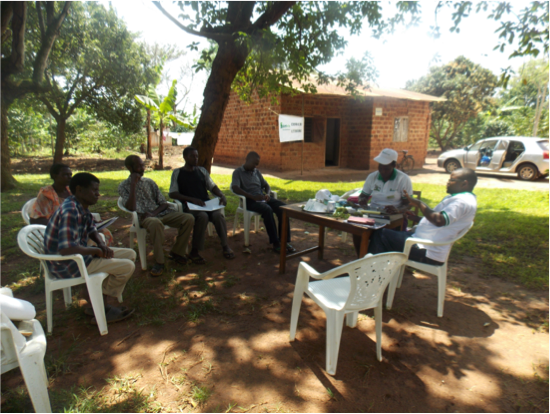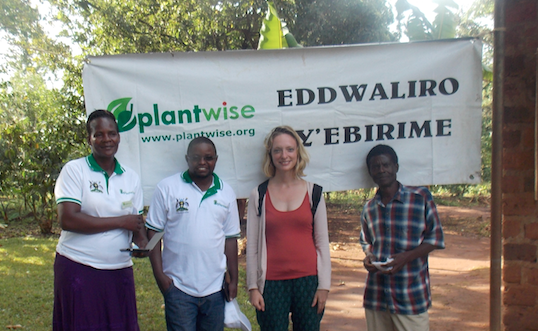Two weeks ago I organised a visit to a plant clinic in the Mukono district of central Uganda. The plant clinics are run by district local government extension staff with support from CABI’s Plantwise programme and offer a place where farmers can bring crop samples to get advice on how to prevent and cure diseases.
Why does Uganda need plant clinics?
It’s estimated that smallholder farmers loose 30 – 40% of their produce to plant health problems before harvest, which threaten food security, income and livelihoods. Ugandan farmers suffer heavily from pests and diseases, including maize stalk borer, wheat rust, banana bacterial wilt, coffee wilt and cassava viral diseases. The situation is always changing, as outbreaks of disease emerge and persist across the country.
Getting access to information is a challenge in rural settings. Often smallholder farmers have very little contact with extension workers and have no way of diagnosing diseases or finding solutions. The plant clinics provide farmers with access to current information to help make rapid, informed decisions that will save their crops. There are now over 191 plant clinics across Uganda and the aim is to have at least one plant clinic in every sub-county by 2020.
On the day…
I was picked up by Benius Tukahirwa an Agricultural Inspector from the Ministry for Agriculture Animal Industry and Fisheries (MAAIF). We drove to Mukono to meet Mukasa Lydia, who’s been a plant doctor for eight years! She has a wealth of plant health knowledge and is in touch with the local community.
When we arrived, we set up a base in the heart of the smallholder village of Nakifuma, Kimenyedde Sub-county, Mukono district. Local farmers find out about the monthly plant clinics through radio announcements and word of mouth. Before long a set of five farmers had arrived with their sickly plant samples. I was told that normally the plant clinics have around 20-50 visitors in a day. On this day the turnout was low as the rains had just started so farmers were in the field planting.
 |
| Local famers gather round to hear advice from the plant doctors |
Patient 1
The first patient to be examined was a passion fruit branch with “woodiness” viral disease, which causes fruit to become misshapen, woody and inedible. The farmer was told to remove and destroy the infected plants immediately to prevent spread to other plants.
Patient 2
The second patient was a coffee plant with coffee berry disease, a fungal disease which causes coffee berries to rot, turn black and mouldy. The farmer was advised to immediately remove and destroy infected branches, and to apply copper based fungicides to the remaining plants.
Patient 3
The third patient I was very familiar with. The farmer had brought a cassava branch with Cassava brown streak viral disease, the leaves showed characteristic yellow patches and tubers were spoiled and inedible. The plant doctors advised him to get hold of some clean, virus-free planting material from a tolerant variety such as NAROCASS 1, NASE 14, NASE 19 from the government.
 |
| Plant patients: passion fruit with woodiness disease (left), coffee wilt disease (middle) and cassava brown streak disease (right) |
The farmer: Kayondo Edrissa told me:
“I have been growing cassava for 20 years. I was hard hit in the 90’s by Cassava mosaic disease (CMD), which totally destroyed cassava crops and caused widespread famine. Since the release of CMD resistant varieties people had begun relying on cassava again. But now these varieties have been overcome with Cassava brown streak disease. I’m not going to plant cassava until I get hold of a variety which can resist the disease. Cassava is the real food which can keep our houses going so we really need a solution.”
After the crops were diagnosed, the plant doctors gave clear instructions for how to prevent or cure the diseases in the local language. These instructions were also sent as text messages to the farmers’ phones. Information and images of the diseases were also uploaded to the Plantwise Knowledge Bank so the government can track and respond to outbreaks. There was a challenge in getting a strong enough internet signal to upload the reports.
We then took a tour of Kayondo’s small-holding where we discovered lots of other problems, including a cassava plant with: CBSD, CMD, bacterial wilt and green mites! I was surprised at how many different plant diseases the farmers are facing. The visit helped me to recognise the importance of the clinics; they offer a meeting point for farmers to learn and communicate with each other and trained extension works about similar problems they are facing.
I would like to thank Plantwise for allowing me to visit the clinic, I had a very informative day!
 |
| Katie Tomlinson |
More from this blog series:
Blog 3: Learning the ropes
Blog 4: Clean cassava to solve brown streak problem?
Blog 5: Taking a trip to the cassava field!
Blog 6: Using GM to fight cassava brown streak disease

